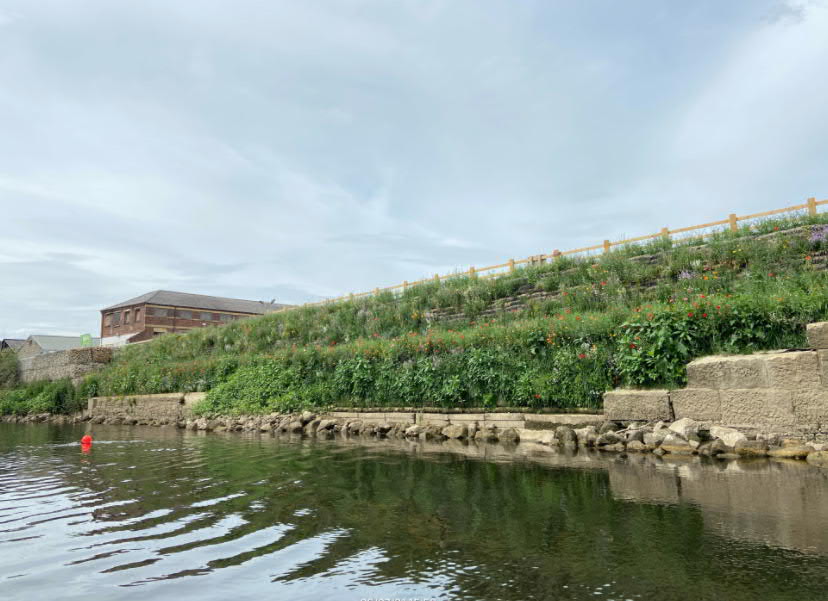Flood alleviation – carbon savings and low carbon innovation
Mark Garford from the Leeds Flood Alleviation Scheme (LFAS2) explains how Leeds City Council is working with their scheme partners to deliver an innovative and low carbon scheme.
What is the LFAS2?
LFAS2 aims to reduce flood risk to communities and businesses along the River Aire corridor between Leeds Rail Station and Apperley Bridge. The area covered by LFAS2 has already experienced severe flooding, most notably on Boxing Day 2015, following Storm Eva.
The scheme will provide a one-in-200-year level of protection against flooding in the LFAS2 area. Once delivered, the scheme will reduce flood risk and provide better protection for 1,048 homes and 474 businesses.
What are the carbon impacts of flooding?
We worked with the Edinburgh Centre for Carbon Innovation at the University of Edinburgh to quantify the carbon impacts associated with flood damages within the City of Leeds. The aim of the study was to estimate the potential carbon savings associated with preventing flood damages granted by the installation of the Leeds Flood Alleviation Scheme (LFAS) Phase 1 and Phase 2.
The Carbon Management students calculated the carbon impacts associated with transport, commercial buildings, and residential buildings, respectively, in 2020. The student’s reports estimated the carbon impacts associated with a 1-in-200-year event within the City of Leeds using the extent of the 2015 Storm Eva Boxing Day flood event and modelled flood extent data as primary information sources.
How does flood alleviation help to reduce carbon?
The carbon savings associated with preventing a major flood event are equivalent to one of the journeys that we have estimated below:
- Driving around the world 950 times in a diesel car
- One person flying one-way from JFK airport, New York to Heathrow airport 6,200 times
- One million trips as a car passenger on the Dover to Calais ferry
Combined, the carbon impacts associated with a single 1-in-200-year flood event, and therefore the carbon emissions potentially prevented by LFAS during a similar event, were calculated to be 51,670 tCO2e. This number provides evidence that LFAS, which is estimated to have a capital carbon footprint of 45,130 tCO2e, delivers a potential net carbon saving of 6,540 tCO2e by protecting the city from a single equivalent flood event.*
What carbon impact does flood defence construction have?
The construction, operation and decommissioning of assets is a major source of greenhouse gases (GHGs), known as carbon equivalents**. The carbon impact of the flood defence construction includes, materials, such as concrete, steel and other materials. Construction also requires the transport of materials to and waste from construction sites, and fuel to generate the electricity that is used to build the assets.
What are Leeds City Council doing to reduce the carbon impact of LFAS2 construction?
Leeds City Council (LCC) has recognised the scale of the challenge of reaching Net Zero emissions in the UK by 2050 by declaring a climate emergency in 2019 and prioritising the reduction of carbon in infrastructure projects.
To address the carbon impact of the scheme, we established a carbon baseline – the quantity of carbon that would be emitted because of the scheme without additional mitigation. The baseline emissions associated with the construction of LFAS2 are estimated to be approximately 23,600 tonnes of CO2 equivalent (tCO2e). That is the equivalent of driving around the world 3,500 times.
We are working closely with engineers and contractors on the project to reach the targets set out below. Carbon specialists are sharing insights from the carbon baseline and suggesting alternative, lower-carbon approaches.
We will continue to monitor progress against our targets as the design progresses.
What are the LFAS2 carbon reduction targets?
Most of the baseline emissions are expected to arise from the use of materials. LCC has set a 20% carbon reduction target from the use of materials. If this target is reached, this would reduce scheme emissions by approximately 3,200 tonnes – shaving off around 480 trips around the world.
Just under 25% of carbon is associated with fuel and electricity use during construction. LCC has set a reduction target of 10% for the carbon from construction energy use. If this target is reached, this would reduce scheme emissions by over 500 tonnes, shaving off another 80 trips around the world.
What innovative approaches as being used on the LFAS2 to reduce carbon?
We are trialling the use of HVO within the plant used for the pilings works in Zone 12 around the Home Office and Kirkstall Valley Farm site. The carbon savings associated with HVO amount to 85-90% reduction compared to regular diesel. HVO is a more refined type of vegetable oil and burns much cleaner than diesel, which results in a cleaner exhaust with up to a third less particulate matter and hydrocarbons. We are using HVO across a wide variety of plant, which is helping to reducing carbon emissions.
We are also using EcoSheetPiles, supplied by Arcelor Mittal, which will contribute to the low carbon initiatives on LFAS2. Sheet piles are sections of sheet materials with interlocking edges that are driven into the ground to provide earth retention and excavation support. On the LFAS2 these are used for flood defences. These energy efficient products are from the range of EcoSheetPiles which are produced in mills located in Luxembourg from circa 100% scrap via electric arc furnace technology, as well as being fully reusable and recyclable.
Footnote
*Although the study by students at the University of Edinburgh provides a positive message, a range of assumptions and limitations have been adopted during the analysis which may lead to an over or under estimation of the calculated carbon damage values derived. Further work is being carried out in 2021 to refine a robust methodology to calculate the carbon damage of flood events and provide an accurate framework.
**When we use the term “carbon”, we are including all six GHGs regulated by the Kyoto Protocol, commonly expressed in tonnes of Carbon Dioxide Equivalent (CO2e)




